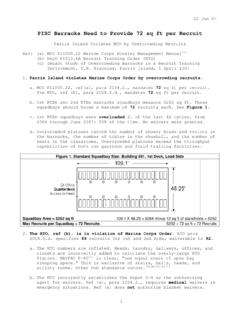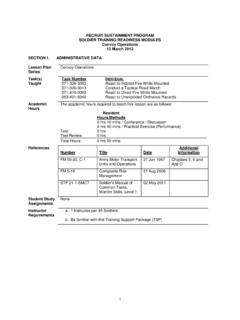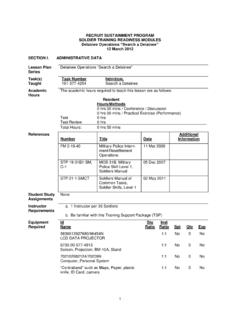Transcription of NFPA 1582 Medical Examination - Connecticut
1 State of Connecticut Department of Emergency Services and Public Protection Connecticut Fire Academy Recruit Firefighter Program nfpa 1582. Medical Examination Guidance for Physician Revision 07/20/2015. This Page Intentionally Left Blank Department of Emergency Services and Public Protection Commission on Fire Prevention and Control nfpa 1582 Medical Examination The Connecticut Fire Academy Guidance for Physician Recruit Firefighter Program During the Medical evaluation, the physician shall evaluate each individual to ascertain the presence of any Medical conditions listed in documents similar to or from the National Fire Protection Association's 1582, Standard on Comprehensive Occupational Medical Program for Fire Departments. The Medical evaluation should also include any Medical conditions not listed which would prevent the individual from performing the Essential Job Tasks of a firefighter without posing significant risk.
2 It is our intent to encourage the use of professional judgment regarding Medical conditions which are not specifically listed in the Medical evaluation reference material specific to the firefighting occupation. A recruit shall NOT be certified as meeting the Medical requirements of these standards if the physician determines that the candidate has any Category "A" Medical condition specified in these standards. Furthermore, a recruit shall not be certified as meeting the Medical requirements of these standards if the physician determines that the candidate has a Category B Medical condition that is of sufficient severity to prevent the recruit from performing the essential functions of a firefighter without posing a significant risk to the safety and health of self or others. For the purpose of these guidelines at minimum the OSHA , Respiratory Protection Program Guidelines Medical Evaluation Questionnaire should be considered as one important and critical element of the overall Medical evaluation process.
3 Essential Firefighter Job Tasks potentially to be Performed (Condensed from nfpa 1582, Standard on Comprehensive Occupational Medical Program for Fire Departments). 1. Performing firefighting tasks hose handling, lifting, crawling, carrying heavy objects, etc, all performed under stressful conditions while in full firefighting gear (PPE). 2. Wearing an SCBA (airpak) in all potential circumstances. 3. Exposure to all forms of potentially toxic environments despite the use of PPE and SCBA. 4. Climbing up to and beyond six flights of stairs in full PPE. 5. Wearing encapsulating/insulated gear causing raised internal temperatures and dehydration. 6. Performing search and rescue of victims, possibly weighing over 200 lbs. 7. Advancing water filled hose lines up to 2 1/2 in diameter, upstairs and around corners. 8. Climbing ladders, working from heights, working in poor visibility and operating around electrical and other hazards.
4 9. Operating in unpredictable emergencies for prolonged periods in extreme conditions without warm-up, rest, nutrition/hydration, or access to medications. 10. Operating fire apparatus in emergency mode (vehicles and equipment). 11. Performing complex problem solving in extreme conditions. 12. Communicating under very poor conditions in full PPE. 13. Functioning as a part of a firefighting team where there are great risks of injury and/or death to emergency responders and civilians. Page 1 of 11 Rev: 07/20/2015. Department of Emergency Services and Public Protection Commission on Fire Prevention and Control nfpa 1582 Medical Examination The Connecticut Fire Academy Guidance for Physician Recruit Firefighter Program The Medical evaluation shall minimally include the following: A comprehensive Medical history A baseline (pre-placement) occupational history, including significant past exposures and training and experience with personal protection equipment Height and Weight Vital signs: pulse, respiration, blood pressure, and, if indicated, temperature Dermatological system Ears, Eyes, Nose, Mouth, Throat Cardiovascular system Respiratory system Gastrointestinal system Genitourinary system Endocrine and metabolic systems Musculoskeletal system Neurological system Mental status evaluation.
5 O Based on the severity, diagnosis, and impairment of any identified behavior or condition, the initial examiner is encouraged to consider referral of the applicant to a doctoral level mental health professional for further evaluation. In general, the current or recent use of psychotropic medications shall be reviewed by a Board certified psychiatrist. Audiometry. o Audiograms should be performed in an ANSI approved "soundproof" booth (ANSI 1977) with equipment calibrated to ANSI standards (ANSI ). If a booth is unavailable, the test room sound pressure levels should not exceed those specified in the Federal OSHA noise regulations (29 CFR ), Visual acuity and peripheral vision testing Pulmonary function testing. o A baseline test should be administered by an experienced individual. Only a spirogram that is technically acceptable and demonstrates the best efforts by an individual should be used to calculate the Forced Vital Capacity (FVC) and Forced Expiratory Volume in one second ( ), Review of hepatitis B immunization status including hepatitis B surface antibody titer if immunized, offer of hepatitis B vaccine if not fully immunized or HbgAb titer less than 10 and documentation of declination if vaccination refused by examinee, A Purified Protein Derivative (PPD) test for tuberculosis, based on individual departmental infection control plans, and, Other diagnostic testing where indicated.
6 The Medical evaluation process should also include: A review of tetanus immunization status. Page 2 of 11 Rev: 07/20/2015. Department of Emergency Services and Public Protection Commission on Fire Prevention and Control nfpa 1582 Medical Examination The Connecticut Fire Academy Guidance for Physician Recruit Firefighter Program All Medical information collected as part of a Medical evaluation shall be considered confidential Medical information, and shall be released by the physician only with the specific written consent of the recruit. The physician shall report the results of the Medical evaluation to the recruit, including any Medical condition(s) disclosed during the Medical evaluation, and the recommendation whether the recruit is medically certified to perform as a firefighter. The physician shall inform the fire department only whether or not the recruit is medically certified to perform as a firefighter.
7 The specific written consent of the recruit shall be required to release confidential Medical information to the fire department, following guidelines set forth under the Americans with Disabilities Act (ADA) and other relevant policies. Category A and Category B Medical Conditions: A Category "A" Medical Condition is a Medical condition that would preclude an individual from performing the essential job tasks of a municipal firefighter in a training or emergency operational environment, or present a significant risk to the safety and health of that individual or others. A Category B Medical Condition is a Medical condition that, based on its severity or degree, may or may not preclude an individual from performing the essential job functions of a municipal firefighter in a training or emergency operational environment, or present a significant risk to the safety and health of that individual or others. The following biological systems should be components of the Medical evaluation for fire fighters: Musculoskeletal Head and Skull o Category A Medical conditions shall include: None.
8 O Category B Medical conditions shall include: Deformities of the skull or loss or congenital absence of the bony substance of the skull which limit the ability to wear a mask and/or protective breathing apparatus, Thoracic outlet syndrome sufficient to compromise required activity, Congenital cysts, chronic draining fistulas, or similar lesions, Any other head condition that results in an individual not being able to perform the job of fire fighter. Neck and Cervical Spine o Category A Medical conditions shall include: None o Category B Medical conditions shall include: Cervical arthrodesis/fusion,/instability Cervical canal stenosis, Cervical radiculopathy or myelopathy, Herniated disc, Degenerative disc disease, Abnormal chronic contraction of neck muscles, Any other neck condition that results in an individual not being able to perform the job of a firefighter Page 3 of 11 Rev: 07/20/2015. Department of Emergency Services and Public Protection Commission on Fire Prevention and Control nfpa 1582 Medical Examination The Connecticut Fire Academy Guidance for Physician Recruit Firefighter Program Thoracic/lumbar/sacral Spine o Category A Medical conditions shall include: Symptomatic spondylolisthesis, whether or not surgically corrected.
9 O Category B Medical conditions shall include: Lumbar laminectomy or discectomy, with or without fusion. Degenerative disease/spondylolysis/pars defect Structural abnormality, fracture, or dislocation, Degenerative disk disease, Herniated disk/sciatica/radiculopathy, Spinal stenosis, Spinal surgery not covered in Category A, Any other spinal condition that results in an individual not being able to perform the job of firefighter Extremities o Category A Medical conditions shall include: Hemipelvectomy, Hip disarticulation, Above-the-ankle amputation, Upper extremity amputation at or above the wrist o Category B Medical conditions shall include: Severe limitation of motion of a joint, fibrosis, or arthrodesis, Other amputations not covered in Category A, Total joint arthroplasty: Shoulder Elbow Wrist Hip Knee Deformity or dislocation of a joint or limb, Joint reconstruction, ligamentous instability, or joint replacement not covered in (iii), Chronic osteoarthritis or traumatic arthritis, Inflammatory arthritis, Osteomyelitis, Compressive neuropathies including carpal tunnel syndrome or ulnar nerve palsy, Required use of stabilizing orthopedic braces, Any other extremity condition that results in an individual not being able to perform the job of firefighter Page 4 of 11 Rev: 07/20/2015.
10 Department of Emergency Services and Public Protection Commission on Fire Prevention and Control nfpa 1582 Medical Examination The Connecticut Fire Academy Guidance for Physician Recruit Firefighter Program Eyes and Vision The Medical evaluation shall minimally include visual acuity (Snellen) and peripheral vision testing using a Titmus or Optec Vision Screener or other similar standardized testing device. Contact lenses are not permitted to meet the uncorrected standard. When the candidate is being tested, he/she must present without wearing contact lenses, so that uncorrected vision can be accurately tested. o Category A Medical conditions shall include: Uncorrected vision worse than 20/100 in either eye, Corrected vision worse than 20/20 in the better eye UNLESS the vision in the good eye alone is at least 20/25 AND the vision with both eyes together is 20/20 or better. Peripheral vision of less than 70 degrees temporally and 45 degrees nasally in either eye AND/OR any history of conditions limiting field of vision will necessitate additional assessment by an eye care professional who will use a Goldmann-type perimeter to determine if the binocular visual field is 140 degrees (at least 70 degrees temporally in each eye) with a III4e isopter.















